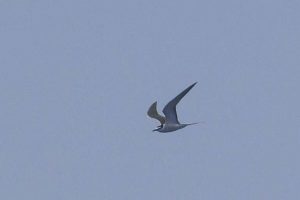Pākalakala
Names
- ʻŌlelo Hawaiʻi: Pākalakala
- Common: Gray-backed Tern, Spectacled Tern
- Scientific: Onychoprio lunatus, Sterna lunata
Song
Conservation Status
- IUCN Red List Ranking – Least Concern
Species Information

Gray-backed tern or Pākalakala. PC: Jacob Drucker
The pākalakala or gray-backed tern (Family: Laridae) is endemic to the central Pacific and breeds on small and remote islands and atolls, however, its historical and current distribution are poorly known. Adults are mostly slate gray above and white below with a black crown and nape. Forehead has a narrow white patch that is continuous with white eye-brow that extends above and past eye and is completely bordered with black. Flight is direct and graceful and body appears to move up and down with each wing beat. Outside the breeding season, may remain in flight continuously. Often forages with ‘ewa‘ewa or sooty terns (S. fuscata) and ‘ua‘u kani or wedge-tailed shearwaters (Puffinus pacificus). Pākalakala (gray-backed terns) feed mainly by plunge diving or by dipping the surface while hovering. Diet primarily consists of fish, especially five-horned cowfish, juvenile flyingfish, goatfish, herring, and dolphinfish, but also eats squid, crustaceans, mollusks, and marine and terrestrial insects. Pākalakala (gray-backed terns) nest in shallow depressions in sand or gravel, and like most seabirds lay a single egg per season. In Hawai‘i, nesting season varies from year to year, but most eggs are laid in February and March and most nestlings start flying by late July. Both males and females incubate egg, and brood and feed the chick. Oldest known bird was 25 years old.
Distribution
Pākalakala (gray-backed terns) breed throughout NWHI, and a few pairs have been recorded breeding on Moku Manu off of the island of O‘ahu. Outside of Hawai‘i, pākalakala (gray-backed terns) nest on the Marianas, Howland and Baker, Johnston, Wake, Jarvis, Line Islands, American Samoa, the Marquesas, and Tuamotu. Non-breeding distribution includes the central Pacific Ocean.
Habitat
Terrestrial: Pākalakala (gray-backed terns) breed on remote islands and atolls. Nests are constructed in a variety of habitats (e.g., rocky ledges, open, sandy beaches) but usually at the base of shrubs or refuse. On Midway and Kure, individuals nest on runways. Nests are typically shallow depressions in sand or gravel and in surf zones, making them vulnerable to storm tides. Marine: Pelagic.
Threats
- Introduced predators. Like all seabirds, adults and nests are susceptible to predation by rats (Rattus spp.), and feral cats (Felis silvestris). All sites in NWHI are free of rats and cats.
- Human disturbance. Pākalakala (gray-backed terns) are sensitive to nest disturbance, and flush from nests when humans approach. Exposed eggs and chicks are vulnerable to predation by ‘iwa or great figatebirds (Fregata minor), ‘akekeke or ruddy turnstones (Arenaria interpres), kioea or bristle-thighed curlews (Numenius tahitiensis), and Laysan (Telespiza cantans) and Nihoa (T. ultima) finches.
- Manmade structures. On Kure, collisions with man-made structures have resulted in mortality.
Additional Resources
For more information and references visit the DLNR State Wildlife Action Plan factsheets. DOFAWʻs species pages and State Wildlife Action Plan fact sheets are provided for general information and are not meant to be a citable, original source of data. If you are a student, researcher, or writer looking for a citable source, please explore the references below or find other original data sources, rather than citing these webpages. The references below were provided by the authors of the State Wildlife Action Plan fact sheets at the time of drafting:
- Kushlan JA, et al. 2002. Waterbird Conservation for the Americas: The North American waterbird conservation plan, Version 1 Waterbird Conservation for the Americas, Washington, DC. 78pp. Available at: www.waterbirdconservation.org.
- Mostello CS, Palaia NA, Clapp RB. 2000. Gray-backed tern (Sterna lunata). In The Birds of North America, No. 525 (Poole A, Gill F, editors). Philadelphia, (PA): The Academy of Natural Sciences; and Washington DC: The American Ornithologists’ Union.
- NatureServe. 2003. Downloadable animal data sets. NatureServe Central Databases. Available at: https://www.natureserve.org/getData/vertinvertdata.jsp (March 10, 2005).
- U.S. Fish and Wildlife Service. 2005. Regional seabird conservation plan, Pacific Region. U.S. Fish and Wildlife Service, Migratory Birds and Habitat Programs, Pacific Region. Portland, (OR): U.S. Fish and Wildlife Service.

